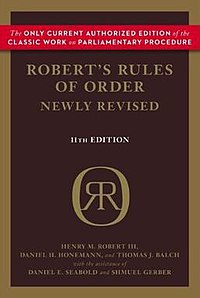「議事規則」 解決 「拉布戰術」
拉布戰術乃美國議會術語,意即拖延時間。
立法會原定今日(9/5/2012)早上繼續審議遞補機制的修訂條例草案,但由於出席議員人數不足一半而流會。有議員批評政府這麼遲才將草案提上立法會,令反對派有機會採取「拉布戰」,相信今次流會及泛民的「拉布戰」,會影響立法會餘下的議程。
「拉布戰術」是美國議會的術語,英文是「Filibuster」,意思是在議會發表冗長演說,拖延表決。「Filibuster」源自西班牙語,原本指十六世紀活躍於加勒比海的海盜,海盜會劫持船隻來勒索贖金,於是引伸出挾持議會的意思。
拉布的最長氣紀錄是美國前參議員瑟蒙德,他在一九五七年發言反對民權法案時,連續演說了二十四小時十八分鐘。他朗讀每個州的選舉法來拖延時間,更讀完《美國獨立宣言》、《美國憲法》和《民權法》等。亦有其他參議員為了拖時間,演說時朗讀聖經、莎士比亞名著,甚至是食譜。
人民力量表明下周三(9/5/2012)復會後,會繼續要求響鐘及拉布。有議員擔心,會影響其他法案審議進度,例如無法如期在本會期通過「一手樓銷售條例草案」。
議事規則委員會下周二會召開會議,研究如何防止拉布,但主席譚耀宗承認,遠水不能救近火,修訂規則要經分組點票,不易通過。
事實上,立法會上演的「拉布」鬧劇,只是本港政治爭拗的一個縮影罷了。香港回歸十二年來,紛紛擾擾,內耗不斷,以致一事無成。最突出的例子是港府近期推出二○一二年政改方案,社會各界本應趁此機會求同存異,推動政制向前發展,但部分泛民政客無視全國人大已訂明香港普選行政長官和立法會時間表的事實,聲稱要以發動「五區總辭」的方式搞「變相公投」。難怪有商界人士慨嘆,立法會議員經常阻礙施政,令政府「輕微癱瘓」,如果本港不是被這種「小政治」的格局所困,相信經濟增長每年可達百分之六至八,也就不至於被內地迅速拋離了。
逆水行舟,不進則退。最近公布的中國城市競爭力排名榜顯示,本港的成長競爭力已由內地城市趕過。「盛年不重來,一日難再晨,及時當勉勵,歲月不待人。」這是陶淵明感嘆時不我待之語,套用在今天,也可以用作內耗不已、坐吃老本的香港的警語。
可以說,政客有機會利用市民的不滿和疑慮,將事件政治化,當局實在難辭其咎。議事規則委員會應該研究如何優化及落實「議事規則」 解決 「拉布戰術」。
Robert's Rules of Order
Robert's Rules of Order is the short title of a book containing rules of order intended to be adopted as a parliamentary authority for use by a deliberative assembly written by Brig. Gen. Henry Martyn Robert.
Currently in its eleventh edition and published under the name Robert's Rules of Order Newly Revised (and often referred to using the initialism RONR) it is the most widely used parliamentary authority in the United States, according to the National Association of Parliamentarians, a professional association of approximately 4,000 members which provides education and accreditation certifications for parliamentarians.
History and origins
The first edition of the book, whose full title was Pocket Manual of Rules of Order for Deliberative Assemblies, was published in February 1876 by then U.S. Army Colonel Henry Martyn Robert (1837–1923) with the short title Robert's Rules of Order placed on its cover. The procedures prescribed by the book were loosely modeled after those used in the United States House of Representatives, with such adaptations as Robert saw fit for use in ordinary societies. The author's interest in parliamentary procedure began in 1863 when he was chosen to preside over a church meeting and, although he accepted the task, felt that he did not have the necessary knowledge of proper procedure. In his later work as an active member of several organizations, he discovered that members from different areas of the country had very different views regarding what the proper parliamentary rules were, and these conflicting views hampered the organizations in their work. He eventually became convinced of the need for a new manual on the subject, one which would enable many organizations to adopt the same set of rules.
Explanation
The book is designed for use in ordinary societies rather than legislative assemblies, and it is the most commonly adopted parliamentary authority among societies in the United States.[3] The book claims to be a "codification of the present-day general parliamentary law (omitting provisions having no application outside legislative bodies)".[4] This statement does not imply any approbation on the part of the courts, and the "general parliamentary law" is related neither to statutory legal requirements nor to common-law precedent derived from court judgments. Being widely accepted, and being based for the most part on long-standing traditions of parliamentary procedure, however, the current edition of the book is a reliable reference. Nevertheless, the provisions of any particular manual are not, as a general matter, legally binding upon an assembly that has not formally adopted it as its parliamentary authority; any such manual can at best be cited as "persuasive".[5] In addition, a number of changes have been made to recent editions, such as provisions dealing with videoconferences, teleconferences, and email, which now makes these editions more than merely codifications of the "present-day general parliamentary law" as existed at the time Robert was originally writing.
Subsequent editions and versions
As Pocket Manual of Rules of Order for Deliberative Assemblies (cover short title: Robert's Rules of Order)
=First Edition – February 1876
=Second Edition – July 1876
=Third Edition – 1893
As Robert's Rules of Order Revised
=Fourth Edition – 1915
=Fifth Edition – 1943
=Sixth Edition ("Seventy-Fifth Anniversary") – 1951
As Robert's Rules of Order Newly Revised
=Seventh Edition – 1970 ("Enlarged more than twofold and totally recast to be made more explanatory")
=Eighth Edition – 1981
=Ninth Edition – 1990
=Tenth Edition – 2000 ("'Millennium,' thoroughly re-edited to refine conceptual clarity and consistency of statement")
=Eleventh Edition – 2011 ("Significantly re-edited with expanded and updated treatment of many topics")
Robert himself published the first four editions before his death in 1923, the last being the thoroughly revised and expanded fourth edition published as Robert's Rules of Order Revised in May 1915. By this time Robert had long been retired from the Army with the rank of brigadier general.
Through a family trust, and later through the Robert's Rules Association, several subsequent editions of Robert's work have been published, including another major revision of the work. The seventh edition, published in February 1970 on the 94th anniversary of the publication of the first edition, was the first under the title Robert's Rules of Order Newly Revised.
The current edition of the series became effective on September 23, 2011[6], and entitled Robert's Rules of Order Newly Revised, Eleventh Edition (2011) (hardback ISBN 978-0-306-82021-2; paperback ISBN 978-0-306-82020-5; leatherbound ISBN 978-0-306-82022-9). This edition states that it:
supersedes all previous editions and is intended automatically to become the parliamentary authority in organizations whose bylaws prescribe "Robert's Rules of Order," "Robert's Rules of Order Revised," "Robert's Rules of Order Newly Revised," or "the current edition of" any of these titles, or the like, without specifying a particular edition.
In addition, since the Tenth Edition of Robert's Rules of Order Newly Revised, a shorter reference guide, Robert's Rules of Order Newly Revised In Brief, has been published to coincide with the main edition. The most recent edition of this shorter guide, the Second Edition, coincides with the current Eleventh Edition of Robert's Rules of Order Newly Revised.
We must learn to run a meeting without victimizing the audience; but more importantly, without being victimized by individuals who are armed with parliamentary procedure and a personal agenda.
Some ThoughtsBrown Act Classes for your Organization (3/28/12)
Robert's Rules of Order Superseded? (3/20/12) | |
Before the Motion
After the Motion
|
During the Motion
|
If one is not armed with the fundamentals of parliamentary procedure, one will suffer surprising consequences such as the ones I have seen in various meetings. Read and be prepared.
| |

沒有留言:
張貼留言